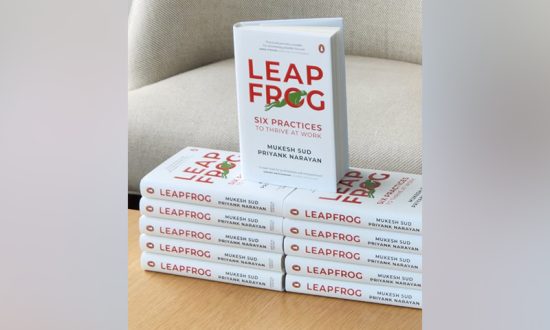Six seems like a small number. What can six practices accomplish? That’s a question that Mukesh Sub and Priyanka Narayan answer for us in their book ‘Leapfrog – Six practices to thrive at work.’
The book is essentially a toolkit for working professionals to get more out of the work they do. It not only shows them what to do but also gives us a glimpse into what the future looks like, and how these practices pay off in the long run.
As mentioned in the book’s introduction, the concept of leapfrogging is defined as when a new entrant in an industrial organisation moves ahead of its competitors. With an example of a bridge across the Cholutea River in Honduras that led to nowhere during the hurricane, the authors bring out their point of how to move from ‘built to last’ to ‘built to thrive.’
Written in a casual tone with interesting anecdotes, ‘Leapfrog’ is one book that is entertaining but also gives you guidance to have a better understanding of work. By changing the perspective of who you are as a person, and an employee, this book helps one realise that there is more to explore within oneself that seldom meets the eye.
Mukesh Sud and Priyank Narayan rake this book to a new level with tips for any young professional that needs guidance in their careers as well as their lives. Coming from a background in business, entrepreneurship, management and innovation, their combined experiences not only makes the book credible but also help one understand that they are on a mission to make a difference.
The book includes a couple of illustrations, excerpts and details that make the book more reader-friendly. It’s not just another self-help book. It gives professionals today a peep into what to expect, how to be successful and what practices to follow to have a successful, if not happy, career. With a toolkit mentioned at the end of the book, the authors have really thought about how to make career paths more sustainable, successful and clear.
The first practice is to develop grit and embrace boredom. The second is to learn how to focus on motivating yourself to make better decisions and choices. The third is to understand that everyone is limited, thus you need to learn how to be intellectually humble. The fourth is about collaboration, combining ideas and ‘dancing with disciplines,’ The fifth practice is to have a minimalist approach in a way, cutting out the noise, and distractions and focusing on what is really important. And finally, the last practice is to give one the tools to help them think like an entrepreneur and contrive an ability to acquire what they need.
By mentoring and training students to their full potential, the authors realised that they created a framework for students, professionals and others to help them absorb and put into practice these steps to design a career path that will be prosperous for them.






